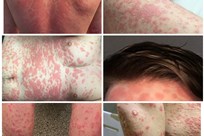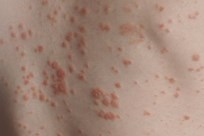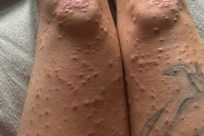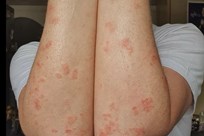Guttate Psoriasis
Guttate psoriasis presents as a widespread rash of small spots, and occurs most often in children, teenagers and young adults.
About guttate psoriasis
Guttate psoriasis is also known as ‘tear drop’ or ‘rain drop’ psoriasis (the name was derived from the Latin, Guttae, which means drops), and is a widespread rash of small spots. It can occur at any age, but tends to occur most often in children, adolescents and younger adults. Usually, guttate psoriasis is widespread across the torso, back and limbs, and clears up after several weeks or months, depending on how quickly treatment is started. Some people may continue to have flares from time to time, or find it evolves into one of the other types of psoriasis.
What are the main symptoms of guttate psoriasis?
Guttate psoriasis causes a rash of small spots (up to 1 centimetre in diameter), which are widespread across the torso, back, limbs, and sometimes neck, head and scalp. These spots are often a bright pink or red on fair skin types, whilst people with darker skin types may notice the psoriasis patches are dark rather than red. There may also be some fine scaling on guttate spots. Some people report guttate psoriasis as being very itchy or sore, whilst others do not notice this.
What causes guttate psoriasis?
Guttate psoriasis seems to occur most often in children, teenagers and young adults, although it can occur in older adults. Guttate psoriasis is often triggered after a streptococcal throat infection, and so people who are prone to this type of infection may experience repeat bouts of guttate psoriasis. In some cases, other viral or bacterial infections may trigger guttate psoriasis.
How can guttate psoriasis be treated?
Psoriasis is a condition that is unique to each person who has it, and so finding a treatment or combination of treatments that work can be a process of trial and error. Click on the headings below to learn about treatments for guttate psoriasis.
Ultraviolet Light Therapy
Antibiotics and Tonsillectomy
February 2017 (Review Date: February 2020)



